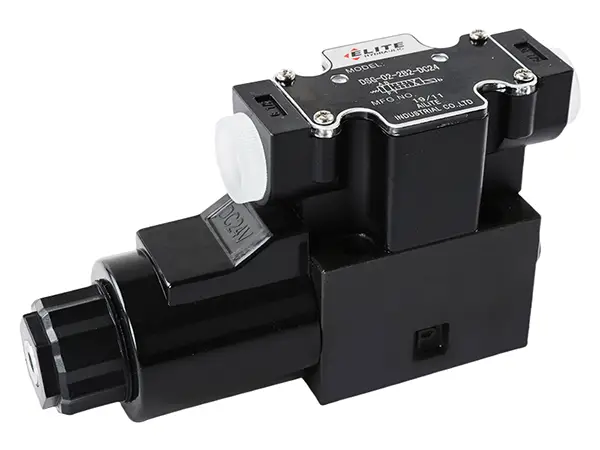
| Max. flow (L/min) | 80 (21GPM) |
| Max. operating pressure (bar) | 320 |
| Allowable back pressure (bar) | 210 |
| Ambient temperature range | -15℃ to 50°C |
| Hydraulic fluid temperature range | -15℃ to 70°C |
| Hydraulic fluid viscosity range | 15-400mm²/s |
| Filtration accuracy | 25µm or better |
| Protection class | Weatherproof conforms to IP65 |
| Max. changeover frequency (cycles/min) | 300 (AC, DC) |
| 12 (RF) | |
| Mounting surface | IS04401-AB-03-4-A |
| Weight (single solenoid) | 1.7kg (AC, RF) 1.6kg (AC) |
| Weight (double solenoid) | 2.1kg (AC, RF) 2.0kg (AC) |
| Fastening bolts (metric) | M5×45mm(length), 4pcs |
| Fastening bolts (inch) | #10-24UNC×1-3/4", 4pcs |
| Tightening torque (Nm) | 5-7 |
| Type | Model | Max. flow (L/min) | Max. operating pressure (MPa) | Allowable back pressure at the return line (MPa) | Max. changeover frequency (min) | Weight (kg) | |
| Type of solenoid | |||||||
| AC | DC, R, RQ | ||||||
| Standard solenoid directional valve |
|
120 | 31.5/25 | 16 | 240/120 | 3.6 | 5 |
|
|
120 | 31.5/25 | 16 | 240/120 | 3.6 | 5 | |
|
|
120 | 31.5/25 | 16 | 240/120 | 2.9 | 3.6 | |
| Shockless solenoid directional valve |
|
120 | 25 | 16 | 120 | — | 5 |
|
|
120 | 25 | 16 | 120 | — | 3.6 | |
| Valve type | Power supply | Coil type | Frequency (Hz) | Voltage (V) | Current and power at rated voltage | |||
| Rated | Serviceable Range | In-rush current (A) | Holding current (A) | Power (W) | ||||
| Standard type | AC | A100 | 50 | 100 | 80~110 | 5.37 | 0.9 | — |
| Standard type | AC | A100 | 60 | 100 | 90~120 | 4.57 | 0.63 | — |
| Standard type | AC | A100 | 60 | 110 | 90~120 | 5.03 | 0.77 | — |
| Standard type | AC | A120 | 50 | 120 | 96~132 | 4.48 | 0.75 | — |
| Standard type | AC | A120 | 60 | 120 | 108~144 | 3.81 | 0.52 | — |
| Standard type | AC | A200 | 50 | 200 | 160~220 | 2.69 | 0.45 | — |
| Standard type | AC | A200 | 60 | 200 | 180~240 | 2.29 | 0.31 | — |
| Standard type | AC | A200 | 60 | 220 | 180~240 | 2.52 | 0.38 | — |
| Standard type | AC | A240 | 50 | 240 | 192~264 | 2.24 | 0.37 | — |
| Standard type | AC | A240 | 60 | 240 | 216~288 | 1.91 | 0.26 | — |
| Shockless type | DC (K series) | D12 | — | 12 | 10.8~13.2 | — | 3.16 | 38 |
| Shockless type | DC (K series) | D24 | — | 24 | 21.6~26.4 | — | 1.57 | 38 |
| Shockless type | DC (K series) | D100 | — | 100 | 90~110 | — | 0.38 | 38 |
| Shockless type | AC-DC rectified | R100 | 50/60 | 100 | 90~110 | — | 0.43 | 38 |
| Shockless type | AC-DC rectified | R200 | 50/60 | 200 | 180~220 | — | 0.21 | 38 |
| Shockless type | AC-DC rectified (quick return) | RQ100 | 50/60 | 100 | 90~110 | — | 0.43 | 38 |
A solenoid directional valve works based on the attractive force of an electromagnet. When the electromagnet is energized, the armature's attractive force pushes the spool to move within the valve body. When power is cut, the spool returns to its original position by the action of a spring.
Directional control valves are used in hydraulic systems to precisely control the flow of hydraulic oil. They achieve directional control of fluid by diverting it in different directions. Fluid can be routed from the source to an actuator, or from an actuator to the return line. This allows for controlling the movement of hydraulic cylinders or hydraulic motors in different directions.
The two primary characteristics to consider when selecting a directional control valve are the number of fluid ports and the number of directional states (or positions) the valve can achieve. Valve ports provide channels for hydraulic fluid to flow to or from other components. The number of positions refers to the number of different flow paths the valve can offer.
If the valve gets stuck, it will be unable to switch from a heating to a cooling position, or vice versa. A faulty solenoid coil can lead to a lack of power in cooling mode. Internal valve leakage is difficult to troubleshoot and is often confused with insufficient compressor pumping capacity. Symptoms of directional valve leakage and compressor failure are the same: a reduction in the system's heating and cooling capacity. This is because the compressor continuously pumps gas internally through the leaking valve, leading to a loss of available cooling.
